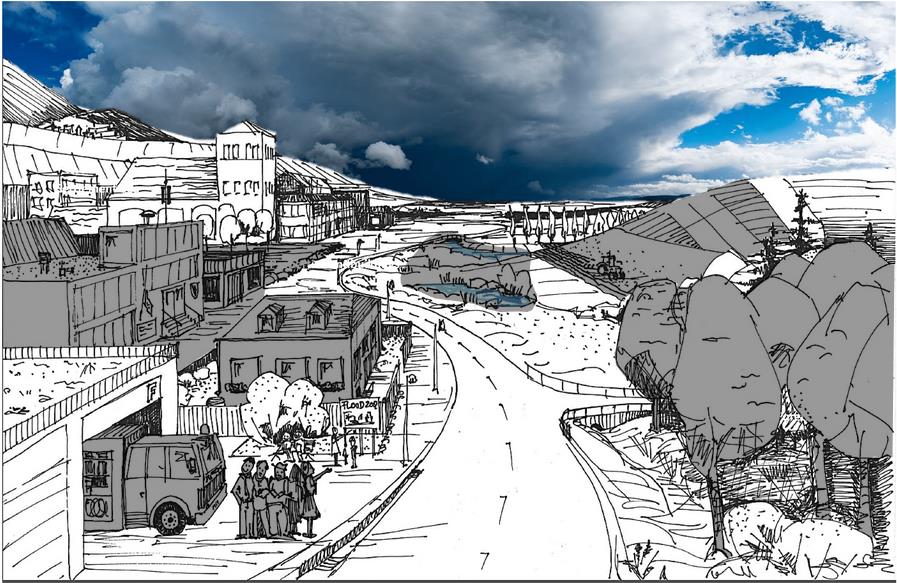Tool RISK REDUCTION MEASURES
Combine different strategies for risk reduction and take all fields of action into account!
On the picture you can see different fields of action (shaded in grey) surrounded by the most relevant strategies to reduce heavy rain risks effectively. Below, you get more insights into the typical risks per field of action. Navigating further, you can either learn more about the respective strategies or select suitable measures from the catalogue of 100 measures directly.
Improve early warning
Learn how to interpret, assess and forward warnings
Organise emergency response
Adapt your emergency response to heavy rain risks
Retain rainwater
Learn about different retention concepts

Prevent damages
Explore what regional authorities, municipalities and private persons can do to prevent damages
Adapt spatial planning
Learn about the risk reduction possibilities of different planning instruments
Select suitable measures
Browse through our catalogue of 100 risk reduction measures
Seek for integrated action…
Each field of action has its individual heavy rain risks, and thus specific precaution strategies can be applied. However, an integrated approach combining different tailored measures, e.g. from planning over technical and behavioural measures up to good risk communication might yield the best effects for the affected people and assets.
Settlement areas are often more vulnerable to damages from heavy rain events  than surrounding areas.
than surrounding areas.
Typical hazards and risks
- The capacities of the sewage system and drainage canals cannot absorb the rainfall or water leaks out of the sewage system at various points, e.g. in streets, basements.
- Fast running surface water with a harmful destructive power (in hilly and mountainous terrain)
- Blocking, damages and sedimentation to surface water drains
- Flooded or destroyed streets
- Swamped cellars and ground levels of buildings
- Destroyed, uninhabitable homes
- Power outage
- Disruptions in traffic, operation or supplies
- Disruptions in (tele-)communication
- Commercial losses
- Despaired citizens and/or citizens in panic
Strategies for reducing risks
Heavy rain resilient, water-sensitive and climate-resistant urban development are central action strategies for settlement areas. Citizens, business people and property owners should be involved.
- Prevent damages by considering a wide range of measures, e.g. decentralise and enhance surface water drainage systems in urban areas.
- Retain rainwater, e.g. maximise water retention capacities within settlement structures by natural and artificial solutions (“sponge city”).
- Adapt spatial planning, e.g. keep flood prone areas and runoff pathways free from building developments.
- Improve early warning and organise emergency response.
 Heavy rainfall can cause damages to crops and to soil due to erosion processes. Agricultural surface runoff can carry sediments and nutrients into built-up areas, streams or habitats.
Heavy rainfall can cause damages to crops and to soil due to erosion processes. Agricultural surface runoff can carry sediments and nutrients into built-up areas, streams or habitats.
Typical hazards and risks
- Crop losses due to extensive and long-term flooding and waterlogging in flat terrain
- Complaints about mud deposit in properties situated below farmland in hilly terrain
- Dangerous landslides in mountainous terrain
- Crop losses due to mud covered or washed away plants and seeds;
- Animals drown
- Loss or compaction of soil
- Impairment of protected areas/species
Strategies for reducing risks
Measures focussing on a sustainable soil management and on the implementation of natural water retention measures are key approaches for risk reduction here. They offer benefits also for other extreme weather conditions, e.g. drought situations. Owners of farmland and farmers should be involved.
- Prevent damages! In case of risks at site (e.g. waterlogging, erosion), care about better drainage and/or adaption of management practices and land use (e.g. by grassing).
- Retain rainwater! Use preferably (natural) water retention Ensure compliance of farming practices with regulations for the sustainable protection of soil.
 Even after heavy rainfall there is almost no surface runoff in healthy and site-appropriate forests. Forests offer optimal conditions for the evaporation and infiltration of rainwater.
Even after heavy rainfall there is almost no surface runoff in healthy and site-appropriate forests. Forests offer optimal conditions for the evaporation and infiltration of rainwater.
Typical hazards and risks
- Losses in yields
- Damages (erosion) on forest paths and clearings
- Damages by driftwood in lower-lying areas in hilly and mountainous terrain
- Dangerous landslides in mountainous terrain
Strategies for reducing risks
Measures focussing on a sustainable forest management and on the implication of natural water retention measures are key approaches for risk reduction in this field of action. Forest owners and forest managers should be involved.
- Prevent damages! In case of damages at site (e.g. erosion), care about better drainage and/or adaption of management practices and improvement of forest health (e.g. rejuvenation); allow natural succession.
- Retain rainwater! Use preferably (natural) water retention measures.
 An overflow of water from water bodies to surrounding areas (river flooding) is subject to conventional flood risk management planning. However, after heavy rainfall, major problems can occur in and along watercourses even without significant river flooding.
An overflow of water from water bodies to surrounding areas (river flooding) is subject to conventional flood risk management planning. However, after heavy rainfall, major problems can occur in and along watercourses even without significant river flooding.
Typical hazards and risks
- Pollution from inflow of surface water and drainage water – causing impairment of protected areas/species due to bad water quality.
- Large debris washed away – causing damages to banks, bridges and to physical flood management structures.
- Erosion and reservoir sedimentation – leading to reduced storage in reservoirs or changes of the flow capacity of riverbeds and canals.
Strategies for reducing risks
Consideration of heavy rain risks in flood risk management planning, an integrated water management as well as the implementation of natural water retention measures are key approaches for risk reduction in this field of action.
- Retain rainwater! Increase the water retention capacity of waterbodies e.g. by reconnecting them to the backwater.
- Combine flood risk management planning from the EU Floods Directive with planning and monitoring processes according to the EU Water Framework Directive. Work towards a holistic and collaborative integrated River Basin Management planning.

Typical hazards and risks
- Water penetrates through building’s openings
- Backpressure of sewerage water
- Damage to materials
- Mud deposition and contamination
- Disruptions in electricity, (tele-)communication, supplies
- Danger to life! (drowning, electrocuting, crushing after roof or wall collapse, …)
- Traumatic feelings (fear, powerlessness, traumatisation)
- Homes become uninhabitable
- Loss of memorabilia, pets and valuables
Strategies for reducing risks
Measures related to buildings (and properties) are mostly protective measures. But also implementation of retention measures is an important task for property owners.
- Prevent damages! Divert surface water away from buildings. Protect existing buildings esp. in flood prone areas and runoff pathways. Make your private emergency plan!
- Retain rainwater! Maximise water retention on properties.
Act systematically...

Before reducing the risks, it is wise to
- understand and assess possible risks first! Heavy rain events can happen anytime and anywhere, with little or no warning time. Find ways to assess how your area is affected in tool ASSESSMENT and MAPPING.
- communicate the risks properly! Affected people have to be aware of and understand the risks of heavy rain sufficiently to be able to act accordingly or implement adequate risk reduction measures. Find inspiration in tool RISK COMMUNICATION.

